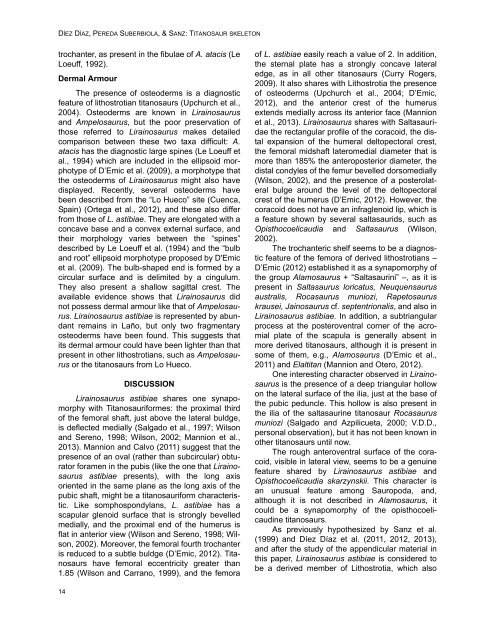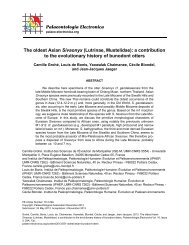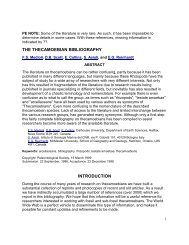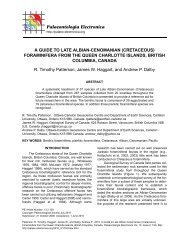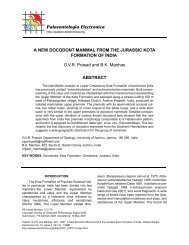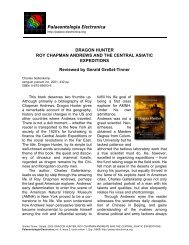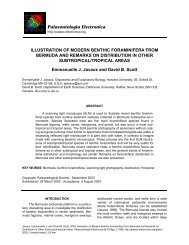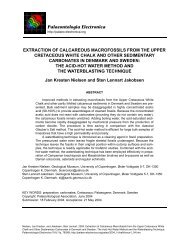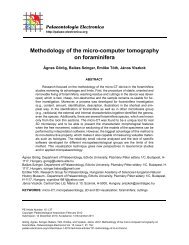Appendicular skeleton and dermal armour of the Late Cretaceous ...
Appendicular skeleton and dermal armour of the Late Cretaceous ...
Appendicular skeleton and dermal armour of the Late Cretaceous ...
Create successful ePaper yourself
Turn your PDF publications into a flip-book with our unique Google optimized e-Paper software.
DÍEZ DÍAZ, PEREDA SUBERBIOLA, & SANZ: TITANOSAUR SKELETON<br />
trochanter, as present in <strong>the</strong> fibulae <strong>of</strong> A. atacis (Le<br />
Loeuff, 1992).<br />
Dermal Armour<br />
The presence <strong>of</strong> osteoderms is a diagnostic<br />
feature <strong>of</strong> lithostrotian titanosaurs (Upchurch et al.,<br />
2004). Osteoderms are known in Lirainosaurus<br />
<strong>and</strong> Ampelosaurus, but <strong>the</strong> poor preservation <strong>of</strong><br />
those referred to Lirainosaurus makes detailed<br />
comparison between <strong>the</strong>se two taxa difficult: A.<br />
atacis has <strong>the</strong> diagnostic large spines (Le Loeuff et<br />
al., 1994) which are included in <strong>the</strong> ellipsoid morphotype<br />
<strong>of</strong> D’Emic et al. (2009), a morphotype that<br />
<strong>the</strong> osteoderms <strong>of</strong> Lirainosaurus might also have<br />
displayed. Recently, several osteoderms have<br />
been described from <strong>the</strong> “Lo Hueco” site (Cuenca,<br />
Spain) (Ortega et al., 2012), <strong>and</strong> <strong>the</strong>se also differ<br />
from those <strong>of</strong> L. astibiae. They are elongated with a<br />
concave base <strong>and</strong> a convex external surface, <strong>and</strong><br />
<strong>the</strong>ir morphology varies between <strong>the</strong> “spines”<br />
described by Le Loeuff et al. (1994) <strong>and</strong> <strong>the</strong> “bulb<br />
<strong>and</strong> root” ellipsoid morphotype proposed by D'Emic<br />
et al. (2009). The bulb-shaped end is formed by a<br />
circular surface <strong>and</strong> is delimited by a cingulum.<br />
They also present a shallow sagittal crest. The<br />
available evidence shows that Lirainosaurus did<br />
not possess <strong>dermal</strong> <strong>armour</strong> like that <strong>of</strong> Ampelosaurus.<br />
Lirainosaurus astibiae is represented by abundant<br />
remains in Laño, but only two fragmentary<br />
osteoderms have been found. This suggests that<br />
its <strong>dermal</strong> <strong>armour</strong> could have been lighter than that<br />
present in o<strong>the</strong>r lithostrotians, such as Ampelosaurus<br />
or <strong>the</strong> titanosaurs from Lo Hueco.<br />
DISCUSSION<br />
Lirainosaurus astibiae shares one synapomorphy<br />
with Titanosauriformes: <strong>the</strong> proximal third<br />
<strong>of</strong> <strong>the</strong> femoral shaft, just above <strong>the</strong> lateral buldge,<br />
is deflected medially (Salgado et al., 1997; Wilson<br />
<strong>and</strong> Sereno, 1998; Wilson, 2002; Mannion et al.,<br />
2013). Mannion <strong>and</strong> Calvo (2011) suggest that <strong>the</strong><br />
presence <strong>of</strong> an oval (ra<strong>the</strong>r than subcircular) obturator<br />
foramen in <strong>the</strong> pubis (like <strong>the</strong> one that Lirainosaurus<br />
astibiae presents), with <strong>the</strong> long axis<br />
oriented in <strong>the</strong> same plane as <strong>the</strong> long axis <strong>of</strong> <strong>the</strong><br />
pubic shaft, might be a titanosauriform characteristic.<br />
Like somphospondylans, L. astibiae has a<br />
scapular glenoid surface that is strongly bevelled<br />
medially, <strong>and</strong> <strong>the</strong> proximal end <strong>of</strong> <strong>the</strong> humerus is<br />
flat in anterior view (Wilson <strong>and</strong> Sereno, 1998; Wilson,<br />
2002). Moreover, <strong>the</strong> femoral fourth trochanter<br />
is reduced to a subtle buldge (D’Emic, 2012). Titanosaurs<br />
have femoral eccentricity greater than<br />
1.85 (Wilson <strong>and</strong> Carrano, 1999), <strong>and</strong> <strong>the</strong> femora<br />
<strong>of</strong> L. astibiae easily reach a value <strong>of</strong> 2. In addition,<br />
<strong>the</strong> sternal plate has a strongly concave lateral<br />
edge, as in all o<strong>the</strong>r titanosaurs (Curry Rogers,<br />
2009). It also shares with Lithostrotia <strong>the</strong> presence<br />
<strong>of</strong> osteoderms (Upchurch et al., 2004; D’Emic,<br />
2012), <strong>and</strong> <strong>the</strong> anterior crest <strong>of</strong> <strong>the</strong> humerus<br />
extends medially across its anterior face (Mannion<br />
et al., 2013). Lirainosaurus shares with Saltasauridae<br />
<strong>the</strong> rectangular pr<strong>of</strong>ile <strong>of</strong> <strong>the</strong> coracoid, <strong>the</strong> distal<br />
expansion <strong>of</strong> <strong>the</strong> humeral deltopectoral crest,<br />
<strong>the</strong> femoral midshaft lateromedial diameter that is<br />
more than 185% <strong>the</strong> anteroposterior diameter, <strong>the</strong><br />
distal condyles <strong>of</strong> <strong>the</strong> femur bevelled dorsomedially<br />
(Wilson, 2002), <strong>and</strong> <strong>the</strong> presence <strong>of</strong> a posterolateral<br />
bulge around <strong>the</strong> level <strong>of</strong> <strong>the</strong> deltopectoral<br />
crest <strong>of</strong> <strong>the</strong> humerus (D’Emic, 2012). However, <strong>the</strong><br />
coracoid does not have an infraglenoid lip, which is<br />
a feature shown by several saltasaurids, such as<br />
Opisthocoelicaudia <strong>and</strong> Saltasaurus (Wilson,<br />
2002).<br />
The trochanteric shelf seems to be a diagnostic<br />
feature <strong>of</strong> <strong>the</strong> femora <strong>of</strong> derived lithostrotians –<br />
D’Emic (2012) established it as a synapomorphy <strong>of</strong><br />
<strong>the</strong> group Alamosaurus + “Saltasaurini” –, as it is<br />
present in Saltasaurus loricatus, Neuquensaurus<br />
australis, Rocasaurus muniozi, Rapetosaurus<br />
krausei, Jainosaurus cf. septentrionalis, <strong>and</strong> also in<br />
Lirainosaurus astibiae. In addition, a subtriangular<br />
process at <strong>the</strong> posteroventral corner <strong>of</strong> <strong>the</strong> acromial<br />
plate <strong>of</strong> <strong>the</strong> scapula is generally absent in<br />
more derived titanosaurs, although it is present in<br />
some <strong>of</strong> <strong>the</strong>m, e.g., Alamosaurus (D’Emic et al.,<br />
2011) <strong>and</strong> Elaltitan (Mannion <strong>and</strong> Otero, 2012).<br />
One interesting character observed in Lirainosaurus<br />
is <strong>the</strong> presence <strong>of</strong> a deep triangular hollow<br />
on <strong>the</strong> lateral surface <strong>of</strong> <strong>the</strong> ilia, just at <strong>the</strong> base <strong>of</strong><br />
<strong>the</strong> pubic peduncle. This hollow is also present in<br />
<strong>the</strong> ilia <strong>of</strong> <strong>the</strong> saltasaurine titanosaur Rocasaurus<br />
muniozi (Salgado <strong>and</strong> Azpilicueta, 2000; V.D.D.,<br />
personal observation), but it has not been known in<br />
o<strong>the</strong>r titanosaurs until now.<br />
The rough anteroventral surface <strong>of</strong> <strong>the</strong> coracoid,<br />
visible in lateral view, seems to be a genuine<br />
feature shared by Lirainosaurus astibiae <strong>and</strong><br />
Opisthocoelicaudia skarzynskii. This character is<br />
an unusual feature among Sauropoda, <strong>and</strong>,<br />
although it is not described in Alamosaurus, it<br />
could be a synapomorphy <strong>of</strong> <strong>the</strong> opisthocoelicaudine<br />
titanosaurs.<br />
As previously hypo<strong>the</strong>sized by Sanz et al.<br />
(1999) <strong>and</strong> Díez Díaz et al. (2011, 2012, 2013),<br />
<strong>and</strong> after <strong>the</strong> study <strong>of</strong> <strong>the</strong> appendicular material in<br />
this paper, Lirainosaurus astibiae is considered to<br />
be a derived member <strong>of</strong> Lithostrotia, which also<br />
14


